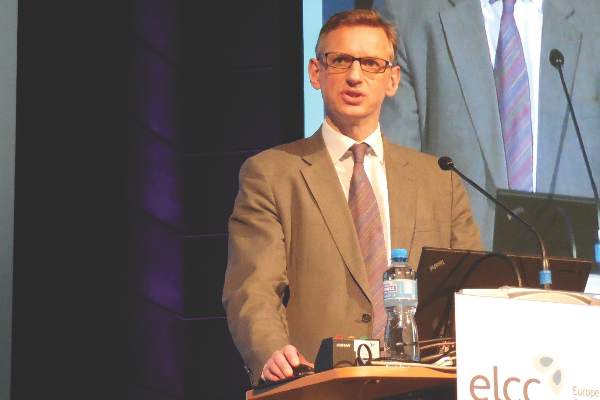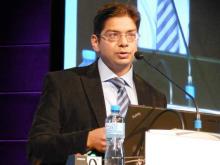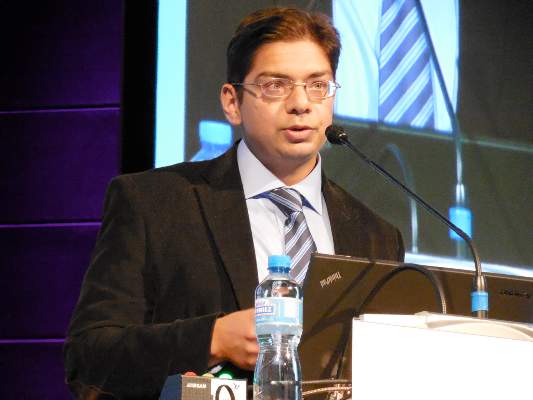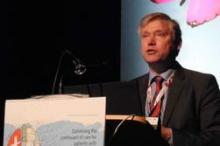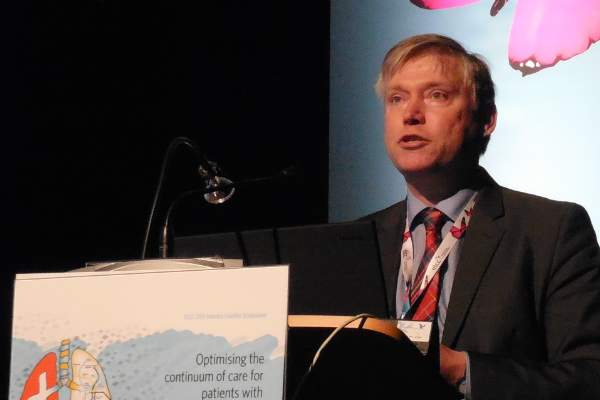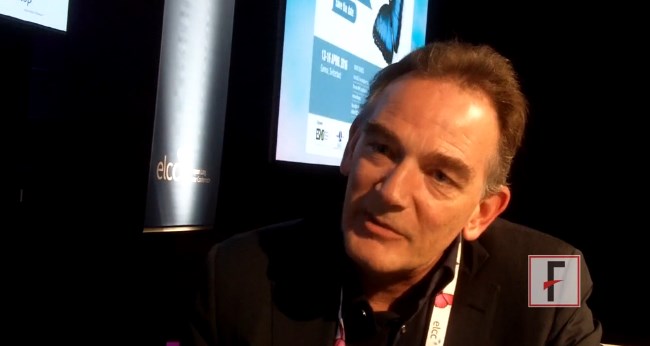User login
European Society for Medical Oncology (ESMO): European Lung Cancer Conference ELCC 2015
ELCC: Survey reveals worldwide underuse of EGFR-mutation testing
GENEVA – Testing for mutations in the epidermal growth factor receptor gene has revolutionized treatment of advanced non–small cell lung cancer, but a significant proportion of patients with these tumors, in North America as well as elsewhere in the world, fail to undergo mutation testing at the time they are diagnosed.
Moreover, even when testing is done and a mutation is identified, a significant minority of patients do not receive treatment with a drug that can exploit their identified mutation, based on results from a recent, worldwide survey of more than 500 clinicians who manage advanced lung cancer patients.
This finding “is especially relevant given recent reports that overall survival is increased compared with chemotherapy when patients receive a specific thymidine kinase inhibitor that is matched to their mutation type,” Dr. James Spicer said at the European Lung Cancer Conference. “The reasons why many patients with cancer that contains a mutation in the EGFR [epidermal growth factor receptor] gene receive chemotherapy first line need to be understood,” said Dr. Spicer, a medical oncologist at Guy’s Hospital, London.
He and his associates ran the survey online during December 2014-January 2015 and received responses from 562 clinicians in 10 countries who manage patients with advanced non–small cell lung cancer (NSCLC), including 412 oncologists, 141 respiratory physicians, and 9 thoracic surgeons. Each clinician treated, on average, 59 newly diagnosed stage-III or -IV NSCLC patients every 3 months. Responses came from 120 U.S. clinicians and 41 from Canada, who formed the North American group of respondents. Another 251 clinicians practice in Europe (France, Germany, Italy, Spain, and the U.K.), and 150 came from Asia (China, Japan, and Korea).
The Asian clinicians tested for the presence of an EGFR mutation most commonly, with 82% saying that they consistently test and await the results before starting treatment, 10% saying they routinely tested but often did not wait for the results before starting treatment, and 8% not testing. This contrasted with 24% of the North American clinicians and 23% of those in Europe who said they did not routinely use EGFR mutation testing; 60% of the North American and 57% of the European clinicians said that they consistently test and use the results to guide their treatment decisions, Dr. Spicer reported.
Clinicians from all three continents showed a similar pattern of reasons why they did not routinely test all advanced NSCLC patients to guide treatment decisions, Tumor histology, for example indicating squamous tissue, was the top reason, cited by two-thirds to three-quarters in the three regions, followed closely by insufficient tissue. Poor performance status of patients was the third most common reason, cited by 21% in Asia, 39% in Europe, and 43% in North America.
Test results not arriving in a timely manner was a problem primarily in Europe and North America. In Europe, 22% of responding clinicians cited delays in getting results and not wanting to wait on initiating treatment as a reason for not testing all patients. In North America, 24% of clinicians cited this reason, compared with 9% of Asian clinicians.
Perhaps most troubling was that, even when testing identifies an EGFR mutation, a significant minority of clinicians on all three continents said that they nonetheless use conventional chemotherapy first and not a thymidine kinase inhibitor. Chemotherapy first was cited by 24% of clinicians in Europe, 19% in Asia, and 17% in North America. In addition, 60% of the clinicians in both Europe and North America said that they do not take into account the specific EGFR mutation identified by testing when deciding on initial treatment, while 28% of Asian respondents said that this was their approach.
“These survey results provide very interesting information but need to be taken with a grain of salt,” commented Dr. Tony S. Mok, the meeting’s designated discussant for the report. “You need to be aware of potential biases,” such as how the survey selected clinicians and the reasons why other clinicians did not respond, information not provided in Dr. Spicer’s report, said Dr. Mok, professor of clinical oncology at the Chinese University of Hong Kong and Prince of Wales Hospital, Hong Kong.
Although there clearly is room for improvement in how EGFR mutation testing is performed worldwide, with the potential to improve specimen quality and cut the time needed to get testing results, the findings from this survey do not provide clear insights into the best ways to improve EGFR mutation testing in patients with newly diagnosed, advanced NSCLC, he said.
The survey was sponsored by Boehringer Ingelheim. Dr. Spicer has been an advisor to and speaker on behalf of Boehringer Ingelheim and had received research funding from the company. Dr. Mok has been a consultant to and speaker on behalf of Boehringer Ingelheim as well as several other drug companies.
On Twitter @mitchelzoler
GENEVA – Testing for mutations in the epidermal growth factor receptor gene has revolutionized treatment of advanced non–small cell lung cancer, but a significant proportion of patients with these tumors, in North America as well as elsewhere in the world, fail to undergo mutation testing at the time they are diagnosed.
Moreover, even when testing is done and a mutation is identified, a significant minority of patients do not receive treatment with a drug that can exploit their identified mutation, based on results from a recent, worldwide survey of more than 500 clinicians who manage advanced lung cancer patients.
This finding “is especially relevant given recent reports that overall survival is increased compared with chemotherapy when patients receive a specific thymidine kinase inhibitor that is matched to their mutation type,” Dr. James Spicer said at the European Lung Cancer Conference. “The reasons why many patients with cancer that contains a mutation in the EGFR [epidermal growth factor receptor] gene receive chemotherapy first line need to be understood,” said Dr. Spicer, a medical oncologist at Guy’s Hospital, London.
He and his associates ran the survey online during December 2014-January 2015 and received responses from 562 clinicians in 10 countries who manage patients with advanced non–small cell lung cancer (NSCLC), including 412 oncologists, 141 respiratory physicians, and 9 thoracic surgeons. Each clinician treated, on average, 59 newly diagnosed stage-III or -IV NSCLC patients every 3 months. Responses came from 120 U.S. clinicians and 41 from Canada, who formed the North American group of respondents. Another 251 clinicians practice in Europe (France, Germany, Italy, Spain, and the U.K.), and 150 came from Asia (China, Japan, and Korea).
The Asian clinicians tested for the presence of an EGFR mutation most commonly, with 82% saying that they consistently test and await the results before starting treatment, 10% saying they routinely tested but often did not wait for the results before starting treatment, and 8% not testing. This contrasted with 24% of the North American clinicians and 23% of those in Europe who said they did not routinely use EGFR mutation testing; 60% of the North American and 57% of the European clinicians said that they consistently test and use the results to guide their treatment decisions, Dr. Spicer reported.
Clinicians from all three continents showed a similar pattern of reasons why they did not routinely test all advanced NSCLC patients to guide treatment decisions, Tumor histology, for example indicating squamous tissue, was the top reason, cited by two-thirds to three-quarters in the three regions, followed closely by insufficient tissue. Poor performance status of patients was the third most common reason, cited by 21% in Asia, 39% in Europe, and 43% in North America.
Test results not arriving in a timely manner was a problem primarily in Europe and North America. In Europe, 22% of responding clinicians cited delays in getting results and not wanting to wait on initiating treatment as a reason for not testing all patients. In North America, 24% of clinicians cited this reason, compared with 9% of Asian clinicians.
Perhaps most troubling was that, even when testing identifies an EGFR mutation, a significant minority of clinicians on all three continents said that they nonetheless use conventional chemotherapy first and not a thymidine kinase inhibitor. Chemotherapy first was cited by 24% of clinicians in Europe, 19% in Asia, and 17% in North America. In addition, 60% of the clinicians in both Europe and North America said that they do not take into account the specific EGFR mutation identified by testing when deciding on initial treatment, while 28% of Asian respondents said that this was their approach.
“These survey results provide very interesting information but need to be taken with a grain of salt,” commented Dr. Tony S. Mok, the meeting’s designated discussant for the report. “You need to be aware of potential biases,” such as how the survey selected clinicians and the reasons why other clinicians did not respond, information not provided in Dr. Spicer’s report, said Dr. Mok, professor of clinical oncology at the Chinese University of Hong Kong and Prince of Wales Hospital, Hong Kong.
Although there clearly is room for improvement in how EGFR mutation testing is performed worldwide, with the potential to improve specimen quality and cut the time needed to get testing results, the findings from this survey do not provide clear insights into the best ways to improve EGFR mutation testing in patients with newly diagnosed, advanced NSCLC, he said.
The survey was sponsored by Boehringer Ingelheim. Dr. Spicer has been an advisor to and speaker on behalf of Boehringer Ingelheim and had received research funding from the company. Dr. Mok has been a consultant to and speaker on behalf of Boehringer Ingelheim as well as several other drug companies.
On Twitter @mitchelzoler
GENEVA – Testing for mutations in the epidermal growth factor receptor gene has revolutionized treatment of advanced non–small cell lung cancer, but a significant proportion of patients with these tumors, in North America as well as elsewhere in the world, fail to undergo mutation testing at the time they are diagnosed.
Moreover, even when testing is done and a mutation is identified, a significant minority of patients do not receive treatment with a drug that can exploit their identified mutation, based on results from a recent, worldwide survey of more than 500 clinicians who manage advanced lung cancer patients.
This finding “is especially relevant given recent reports that overall survival is increased compared with chemotherapy when patients receive a specific thymidine kinase inhibitor that is matched to their mutation type,” Dr. James Spicer said at the European Lung Cancer Conference. “The reasons why many patients with cancer that contains a mutation in the EGFR [epidermal growth factor receptor] gene receive chemotherapy first line need to be understood,” said Dr. Spicer, a medical oncologist at Guy’s Hospital, London.
He and his associates ran the survey online during December 2014-January 2015 and received responses from 562 clinicians in 10 countries who manage patients with advanced non–small cell lung cancer (NSCLC), including 412 oncologists, 141 respiratory physicians, and 9 thoracic surgeons. Each clinician treated, on average, 59 newly diagnosed stage-III or -IV NSCLC patients every 3 months. Responses came from 120 U.S. clinicians and 41 from Canada, who formed the North American group of respondents. Another 251 clinicians practice in Europe (France, Germany, Italy, Spain, and the U.K.), and 150 came from Asia (China, Japan, and Korea).
The Asian clinicians tested for the presence of an EGFR mutation most commonly, with 82% saying that they consistently test and await the results before starting treatment, 10% saying they routinely tested but often did not wait for the results before starting treatment, and 8% not testing. This contrasted with 24% of the North American clinicians and 23% of those in Europe who said they did not routinely use EGFR mutation testing; 60% of the North American and 57% of the European clinicians said that they consistently test and use the results to guide their treatment decisions, Dr. Spicer reported.
Clinicians from all three continents showed a similar pattern of reasons why they did not routinely test all advanced NSCLC patients to guide treatment decisions, Tumor histology, for example indicating squamous tissue, was the top reason, cited by two-thirds to three-quarters in the three regions, followed closely by insufficient tissue. Poor performance status of patients was the third most common reason, cited by 21% in Asia, 39% in Europe, and 43% in North America.
Test results not arriving in a timely manner was a problem primarily in Europe and North America. In Europe, 22% of responding clinicians cited delays in getting results and not wanting to wait on initiating treatment as a reason for not testing all patients. In North America, 24% of clinicians cited this reason, compared with 9% of Asian clinicians.
Perhaps most troubling was that, even when testing identifies an EGFR mutation, a significant minority of clinicians on all three continents said that they nonetheless use conventional chemotherapy first and not a thymidine kinase inhibitor. Chemotherapy first was cited by 24% of clinicians in Europe, 19% in Asia, and 17% in North America. In addition, 60% of the clinicians in both Europe and North America said that they do not take into account the specific EGFR mutation identified by testing when deciding on initial treatment, while 28% of Asian respondents said that this was their approach.
“These survey results provide very interesting information but need to be taken with a grain of salt,” commented Dr. Tony S. Mok, the meeting’s designated discussant for the report. “You need to be aware of potential biases,” such as how the survey selected clinicians and the reasons why other clinicians did not respond, information not provided in Dr. Spicer’s report, said Dr. Mok, professor of clinical oncology at the Chinese University of Hong Kong and Prince of Wales Hospital, Hong Kong.
Although there clearly is room for improvement in how EGFR mutation testing is performed worldwide, with the potential to improve specimen quality and cut the time needed to get testing results, the findings from this survey do not provide clear insights into the best ways to improve EGFR mutation testing in patients with newly diagnosed, advanced NSCLC, he said.
The survey was sponsored by Boehringer Ingelheim. Dr. Spicer has been an advisor to and speaker on behalf of Boehringer Ingelheim and had received research funding from the company. Dr. Mok has been a consultant to and speaker on behalf of Boehringer Ingelheim as well as several other drug companies.
On Twitter @mitchelzoler
AT ELCC 2015
Key clinical point: A significant minority of advanced lung cancer patients worldwide fail to receive initial treatment guided by EGFR-mutation testing.
Major finding: Among patients initially diagnosed with advanced lung cancer 17%-24% received conventional chemotherapy despite having an EGFR mutation.
Data source: Online, worldwide survey of 562 clinicians who routinely manage patients with advanced non–small cell lung cancer.
Disclosures: Survey was sponsored by Boehringer Ingelheim. Dr. Spicer has been an advisor to and speaker on behalf of Boehringer Ingelheim and had received research funding from the company. Dr. Mok has been a consultant to and speaker on behalf of Boehringer Ingelheim as well as several other drug companies.
ELCC: Urine tumor DNA shows high testing promise
GENEVA – Blood sampling provides a less invasive alternative to tumor biopsy for collecting cancer DNA for mutation testing, but retrieving tumor DNA from a patient’s urine is least invasive of all.
In an early phase of clinical investigation, researchers assessed the feasibility of using urine to collect cell-free tumor DNA to detect mutations in 34 patients with advanced non–small cell lung cancer. The results suggested that testing circulating tumor (ct) DNA isolated from patients’ urine was sensitive compared with testing DNA from biopsied specimens of the primary tumor, and it was able to flag tumor changes early, before clinically-identifiable effects appeared, Dr. Hatim Husain said at the European Lung Cancer Conference.
He used ctDNA isolated from patients’ urine to test for the presence of three different resistance mutations within the epidermal growth factor receptor (EGFR) gene. Genetic testing of biopsy specimens showed 10 patients carried the T790M mutation, 18 carried an exon 19 deletion, and eight carried an exon 21 L858R mutation. Of these 36 mutations in 34 patients, testing ctDNA isolated from urine identified 35 as positive, a 97% overall concordance rate.
In addition, testing with ctDNA from urine also picked up three additional T790M mutations not seen in the three corresponding tumor-biopsy specimens, but in patients with high clinical suspicion for carrying an EGFR mutation, Dr. Husain reported.
Further evidence for the utility of urinary ctDNA came from following 22 patients on treatment with erlotinib (Tarceva) and monitored for their acquisition of an EGFR-gene mutation making the tumor erlotinib resistant. Dr. Husain and his associates ran a DNA test every 3-6 weeks and tracked the time until patients developed radiographic progression. Using urinary ctDNA, they found four patients who developed EGFR mutations 29-111 days before clinical progression of the tumor became radiographically apparent.
The ctDNA that ends up in a patient’s urine starts out circulating in the blood; urine works as the main elimination route. Urine ctDNA is more concentrated than in blood, and ctDNA remains stable in urine at ambient temperature for 2 weeks, said Dr. Husain, an oncology researcher at the University of California San Diego, La Jolla.
“These interim results suggest that use of urinary ctDNA has potential to detect EGFR T790M status in a higher number of study subjects and may make some patients eligible for therapy who would by tissue biopsy be falsely classified as negative,” Dr. Husain said in a written statement. “Detecting the emergence of EGFR T790M mutations before progression has the potential to enable physicians to better align therapeutic selection and inform early therapeutic decision making,” he said.
Testing ctDNA in patients’ urine is a “novel way to do noninvasive testing,” said Dr. Egbert F. Smit, professor of pulmonary medicine at VU University Medical Center in Amsterdam and the meeting’s designated discussant for Dr. Husain’s report. “It’s attractive for collecting ctDNA because you get a high concentration, and it has potential for a high level of sensitivity. It may have potential for showing how a tumor reacts to treatment. The method seems robust, but we still need data on reproducibility and cost effectiveness,” Dr. Smit cautioned.
On Twitter @mitchelzoler
GENEVA – Blood sampling provides a less invasive alternative to tumor biopsy for collecting cancer DNA for mutation testing, but retrieving tumor DNA from a patient’s urine is least invasive of all.
In an early phase of clinical investigation, researchers assessed the feasibility of using urine to collect cell-free tumor DNA to detect mutations in 34 patients with advanced non–small cell lung cancer. The results suggested that testing circulating tumor (ct) DNA isolated from patients’ urine was sensitive compared with testing DNA from biopsied specimens of the primary tumor, and it was able to flag tumor changes early, before clinically-identifiable effects appeared, Dr. Hatim Husain said at the European Lung Cancer Conference.
He used ctDNA isolated from patients’ urine to test for the presence of three different resistance mutations within the epidermal growth factor receptor (EGFR) gene. Genetic testing of biopsy specimens showed 10 patients carried the T790M mutation, 18 carried an exon 19 deletion, and eight carried an exon 21 L858R mutation. Of these 36 mutations in 34 patients, testing ctDNA isolated from urine identified 35 as positive, a 97% overall concordance rate.
In addition, testing with ctDNA from urine also picked up three additional T790M mutations not seen in the three corresponding tumor-biopsy specimens, but in patients with high clinical suspicion for carrying an EGFR mutation, Dr. Husain reported.
Further evidence for the utility of urinary ctDNA came from following 22 patients on treatment with erlotinib (Tarceva) and monitored for their acquisition of an EGFR-gene mutation making the tumor erlotinib resistant. Dr. Husain and his associates ran a DNA test every 3-6 weeks and tracked the time until patients developed radiographic progression. Using urinary ctDNA, they found four patients who developed EGFR mutations 29-111 days before clinical progression of the tumor became radiographically apparent.
The ctDNA that ends up in a patient’s urine starts out circulating in the blood; urine works as the main elimination route. Urine ctDNA is more concentrated than in blood, and ctDNA remains stable in urine at ambient temperature for 2 weeks, said Dr. Husain, an oncology researcher at the University of California San Diego, La Jolla.
“These interim results suggest that use of urinary ctDNA has potential to detect EGFR T790M status in a higher number of study subjects and may make some patients eligible for therapy who would by tissue biopsy be falsely classified as negative,” Dr. Husain said in a written statement. “Detecting the emergence of EGFR T790M mutations before progression has the potential to enable physicians to better align therapeutic selection and inform early therapeutic decision making,” he said.
Testing ctDNA in patients’ urine is a “novel way to do noninvasive testing,” said Dr. Egbert F. Smit, professor of pulmonary medicine at VU University Medical Center in Amsterdam and the meeting’s designated discussant for Dr. Husain’s report. “It’s attractive for collecting ctDNA because you get a high concentration, and it has potential for a high level of sensitivity. It may have potential for showing how a tumor reacts to treatment. The method seems robust, but we still need data on reproducibility and cost effectiveness,” Dr. Smit cautioned.
On Twitter @mitchelzoler
GENEVA – Blood sampling provides a less invasive alternative to tumor biopsy for collecting cancer DNA for mutation testing, but retrieving tumor DNA from a patient’s urine is least invasive of all.
In an early phase of clinical investigation, researchers assessed the feasibility of using urine to collect cell-free tumor DNA to detect mutations in 34 patients with advanced non–small cell lung cancer. The results suggested that testing circulating tumor (ct) DNA isolated from patients’ urine was sensitive compared with testing DNA from biopsied specimens of the primary tumor, and it was able to flag tumor changes early, before clinically-identifiable effects appeared, Dr. Hatim Husain said at the European Lung Cancer Conference.
He used ctDNA isolated from patients’ urine to test for the presence of three different resistance mutations within the epidermal growth factor receptor (EGFR) gene. Genetic testing of biopsy specimens showed 10 patients carried the T790M mutation, 18 carried an exon 19 deletion, and eight carried an exon 21 L858R mutation. Of these 36 mutations in 34 patients, testing ctDNA isolated from urine identified 35 as positive, a 97% overall concordance rate.
In addition, testing with ctDNA from urine also picked up three additional T790M mutations not seen in the three corresponding tumor-biopsy specimens, but in patients with high clinical suspicion for carrying an EGFR mutation, Dr. Husain reported.
Further evidence for the utility of urinary ctDNA came from following 22 patients on treatment with erlotinib (Tarceva) and monitored for their acquisition of an EGFR-gene mutation making the tumor erlotinib resistant. Dr. Husain and his associates ran a DNA test every 3-6 weeks and tracked the time until patients developed radiographic progression. Using urinary ctDNA, they found four patients who developed EGFR mutations 29-111 days before clinical progression of the tumor became radiographically apparent.
The ctDNA that ends up in a patient’s urine starts out circulating in the blood; urine works as the main elimination route. Urine ctDNA is more concentrated than in blood, and ctDNA remains stable in urine at ambient temperature for 2 weeks, said Dr. Husain, an oncology researcher at the University of California San Diego, La Jolla.
“These interim results suggest that use of urinary ctDNA has potential to detect EGFR T790M status in a higher number of study subjects and may make some patients eligible for therapy who would by tissue biopsy be falsely classified as negative,” Dr. Husain said in a written statement. “Detecting the emergence of EGFR T790M mutations before progression has the potential to enable physicians to better align therapeutic selection and inform early therapeutic decision making,” he said.
Testing ctDNA in patients’ urine is a “novel way to do noninvasive testing,” said Dr. Egbert F. Smit, professor of pulmonary medicine at VU University Medical Center in Amsterdam and the meeting’s designated discussant for Dr. Husain’s report. “It’s attractive for collecting ctDNA because you get a high concentration, and it has potential for a high level of sensitivity. It may have potential for showing how a tumor reacts to treatment. The method seems robust, but we still need data on reproducibility and cost effectiveness,” Dr. Smit cautioned.
On Twitter @mitchelzoler
AT ELCC 2015
Key clinical point: Urine showed potential as a fully noninvasive source for circulating tumor DNA with high testing concordance compared with tumor-biopsy DNA in initial clinical experience with 34 lung cancer patients.
Major finding: Urine circulating tumor DNA had overall concordance of 97% compared with tumor-biopsy DNA for detecting treatment-altering mutations.
Data source: Single-center study of 34 patients with advanced non-small cell lung cancer.
Disclosures: The study was sponsored by Trovagene, the company developing the tests used in the study. Several coauthors on the study are Trovagene employees. Dr. Husain had no personal disclosures.
ELCC: NSCLC mutation testing highlights ctDNA’s limitations
GENEVA – The tests widely available today that use a cancer patient’s tumor DNA that circulates in the blood to detect a treatment-altering lung cancer mutation vary widely in sensitivity, meaning that using circulating DNA to identify a clinically important mutation should be limited to when biopsying the primary does not yield enough DNA for testing.
“It is important to use robust and sensitive methods” when trying to match treatment to the molecular specificities of each patient’s tumor, Dr. Martin Reck said at the European Lung Cancer Conference.
Results from a study that prospectively compared DNA analysis for mutations in the epidermal growth factor receptor (EGFR) gene in tumor biopsies from 1,162 patients with advanced non–small cell lung cancer with DNA analysis of circulating tumor DNA (ctDNA) from the same patients showed that ctDNA analysis had 46% sensitivity, compared with tumor biopsy DNA, reported Dr. Reck, a thoracic oncologist at the Lung Clinic in Grosshandsdorf, Germany. This high level of false-negative results with ctDNA analysis produced a positive predictive value of 78%. In contrast, ctDNA has a specificity of 97% and a negative predictive value of 90%.
The results from the international study, which included 881 patients from seven European countries plus 281 patients from Japan, highlighted the divergent concordance among EGFR mutation comparisons of ctDNA and biopsy DNA depending on which DNA tests were used. Participating physicians could order whichever genetic analyses they wanted. A subanalysis of the study showed, for example, that among the 138 patients whose tumor and ctDNAs were both evaluated for EGFR mutations using the therascreen test marketed by QIAGEN the concordance rose to 95%, the sensitivity of ctDNA was 73%, and the positive predictive value was 94%, Dr. Reck reported.
The Europe-Japan Diagnostic Study for EGFR Testing (ASSESS) enrolled patients with either newly diagnosed, locally advanced stage IIIA or IIIB metastatic non–small cell lung cancer or patients with recurrent non–small cell lung cancer following surgical resection. Patients averaged about 67 years old, and about 85% had stage IV disease. The genetic analyses identified EGFR mutations in 31% of the Japanese patients and in 12% of those in Europe.
On Twitter @mitchelzoler
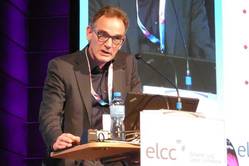 |
| Mitchel L. Zoler/Frontline Medical News Dr. Egbert F. Smit |
The ASSESS study is the largest evaluation of using ctDNA to test the status of a lung tumor for the presence of a mutation in the gene for the epidermal growth factor receptor. It also gives us insight into the feasibility and effectiveness of using this approach in routine practice, outside of a rigorously designed trial. The result was that mutation testing using plasma specimens to obtain circulating tumor DNA was generally doable but resulted in low sensitivity and a low positive predictive value.
The low sensitivity seen overall in ASSESS likely resulted from the multiple testing reagents, commercially available testing kits, and in-house techniques used by individual laboratories in this international study done in diverse settings. Some of the tests for epidermal growth factor receptor (EGFR) mutations are quite sensitive, and others less so. The specific testing method used matters quite a lot. The heterogeneity of methods used in ASSESS reflects the diversity of what usually happens in real-world practice.
Based on the sensitivity limitations, I currently see using ctDNA to test for EGFR mutations only when this is the only option for mutation assessment because a conventional biopsy of the primary tumor failed to provide enough DNA for EGFR mutation testing. Although it is hard to find specific numbers on how often this situation arises in current practice, it seems to happen roughly 10%-30% of the time. So, for about one-fifth of patients with newly diagnosed or recurrent stage III or IV lung cancer EGFR mutation assessment using ctDNA will be necessary.
The data from ASSESS and other studies show that when ctDNA testing identifies an EGFR mutation you can rely on its accuracy. The problem is when ctDNA testing fails to identify an EGFR mutation. In those situations you need to be cautious as you can’t rely on a negative result as being a true negative. I would also be cautious about using ctDNA testing to follow lung cancer patients, as the clinical importance of finding new EGFR alleles appearing in the patient’s blood over time is not yet clear. We need more studies that follow these patients and changes in their EGFR ctDNA over time to determine the clinical relevance of these changes.
The results from ASSESS add to the existing body of evidence that ctDNA testing to find EGFR mutations is feasible in a real-world setting.
Dr. Egbert F. Smit is a professor of pulmonary medicine at the VU University Medical Center in Amsterdam.He had no relevant disclosures. He made these comments in an interview and as the designated discussant for the ASSESS study at the meeting.
 |
| Mitchel L. Zoler/Frontline Medical News Dr. Egbert F. Smit |
The ASSESS study is the largest evaluation of using ctDNA to test the status of a lung tumor for the presence of a mutation in the gene for the epidermal growth factor receptor. It also gives us insight into the feasibility and effectiveness of using this approach in routine practice, outside of a rigorously designed trial. The result was that mutation testing using plasma specimens to obtain circulating tumor DNA was generally doable but resulted in low sensitivity and a low positive predictive value.
The low sensitivity seen overall in ASSESS likely resulted from the multiple testing reagents, commercially available testing kits, and in-house techniques used by individual laboratories in this international study done in diverse settings. Some of the tests for epidermal growth factor receptor (EGFR) mutations are quite sensitive, and others less so. The specific testing method used matters quite a lot. The heterogeneity of methods used in ASSESS reflects the diversity of what usually happens in real-world practice.
Based on the sensitivity limitations, I currently see using ctDNA to test for EGFR mutations only when this is the only option for mutation assessment because a conventional biopsy of the primary tumor failed to provide enough DNA for EGFR mutation testing. Although it is hard to find specific numbers on how often this situation arises in current practice, it seems to happen roughly 10%-30% of the time. So, for about one-fifth of patients with newly diagnosed or recurrent stage III or IV lung cancer EGFR mutation assessment using ctDNA will be necessary.
The data from ASSESS and other studies show that when ctDNA testing identifies an EGFR mutation you can rely on its accuracy. The problem is when ctDNA testing fails to identify an EGFR mutation. In those situations you need to be cautious as you can’t rely on a negative result as being a true negative. I would also be cautious about using ctDNA testing to follow lung cancer patients, as the clinical importance of finding new EGFR alleles appearing in the patient’s blood over time is not yet clear. We need more studies that follow these patients and changes in their EGFR ctDNA over time to determine the clinical relevance of these changes.
The results from ASSESS add to the existing body of evidence that ctDNA testing to find EGFR mutations is feasible in a real-world setting.
Dr. Egbert F. Smit is a professor of pulmonary medicine at the VU University Medical Center in Amsterdam.He had no relevant disclosures. He made these comments in an interview and as the designated discussant for the ASSESS study at the meeting.
 |
| Mitchel L. Zoler/Frontline Medical News Dr. Egbert F. Smit |
The ASSESS study is the largest evaluation of using ctDNA to test the status of a lung tumor for the presence of a mutation in the gene for the epidermal growth factor receptor. It also gives us insight into the feasibility and effectiveness of using this approach in routine practice, outside of a rigorously designed trial. The result was that mutation testing using plasma specimens to obtain circulating tumor DNA was generally doable but resulted in low sensitivity and a low positive predictive value.
The low sensitivity seen overall in ASSESS likely resulted from the multiple testing reagents, commercially available testing kits, and in-house techniques used by individual laboratories in this international study done in diverse settings. Some of the tests for epidermal growth factor receptor (EGFR) mutations are quite sensitive, and others less so. The specific testing method used matters quite a lot. The heterogeneity of methods used in ASSESS reflects the diversity of what usually happens in real-world practice.
Based on the sensitivity limitations, I currently see using ctDNA to test for EGFR mutations only when this is the only option for mutation assessment because a conventional biopsy of the primary tumor failed to provide enough DNA for EGFR mutation testing. Although it is hard to find specific numbers on how often this situation arises in current practice, it seems to happen roughly 10%-30% of the time. So, for about one-fifth of patients with newly diagnosed or recurrent stage III or IV lung cancer EGFR mutation assessment using ctDNA will be necessary.
The data from ASSESS and other studies show that when ctDNA testing identifies an EGFR mutation you can rely on its accuracy. The problem is when ctDNA testing fails to identify an EGFR mutation. In those situations you need to be cautious as you can’t rely on a negative result as being a true negative. I would also be cautious about using ctDNA testing to follow lung cancer patients, as the clinical importance of finding new EGFR alleles appearing in the patient’s blood over time is not yet clear. We need more studies that follow these patients and changes in their EGFR ctDNA over time to determine the clinical relevance of these changes.
The results from ASSESS add to the existing body of evidence that ctDNA testing to find EGFR mutations is feasible in a real-world setting.
Dr. Egbert F. Smit is a professor of pulmonary medicine at the VU University Medical Center in Amsterdam.He had no relevant disclosures. He made these comments in an interview and as the designated discussant for the ASSESS study at the meeting.
GENEVA – The tests widely available today that use a cancer patient’s tumor DNA that circulates in the blood to detect a treatment-altering lung cancer mutation vary widely in sensitivity, meaning that using circulating DNA to identify a clinically important mutation should be limited to when biopsying the primary does not yield enough DNA for testing.
“It is important to use robust and sensitive methods” when trying to match treatment to the molecular specificities of each patient’s tumor, Dr. Martin Reck said at the European Lung Cancer Conference.
Results from a study that prospectively compared DNA analysis for mutations in the epidermal growth factor receptor (EGFR) gene in tumor biopsies from 1,162 patients with advanced non–small cell lung cancer with DNA analysis of circulating tumor DNA (ctDNA) from the same patients showed that ctDNA analysis had 46% sensitivity, compared with tumor biopsy DNA, reported Dr. Reck, a thoracic oncologist at the Lung Clinic in Grosshandsdorf, Germany. This high level of false-negative results with ctDNA analysis produced a positive predictive value of 78%. In contrast, ctDNA has a specificity of 97% and a negative predictive value of 90%.
The results from the international study, which included 881 patients from seven European countries plus 281 patients from Japan, highlighted the divergent concordance among EGFR mutation comparisons of ctDNA and biopsy DNA depending on which DNA tests were used. Participating physicians could order whichever genetic analyses they wanted. A subanalysis of the study showed, for example, that among the 138 patients whose tumor and ctDNAs were both evaluated for EGFR mutations using the therascreen test marketed by QIAGEN the concordance rose to 95%, the sensitivity of ctDNA was 73%, and the positive predictive value was 94%, Dr. Reck reported.
The Europe-Japan Diagnostic Study for EGFR Testing (ASSESS) enrolled patients with either newly diagnosed, locally advanced stage IIIA or IIIB metastatic non–small cell lung cancer or patients with recurrent non–small cell lung cancer following surgical resection. Patients averaged about 67 years old, and about 85% had stage IV disease. The genetic analyses identified EGFR mutations in 31% of the Japanese patients and in 12% of those in Europe.
On Twitter @mitchelzoler
GENEVA – The tests widely available today that use a cancer patient’s tumor DNA that circulates in the blood to detect a treatment-altering lung cancer mutation vary widely in sensitivity, meaning that using circulating DNA to identify a clinically important mutation should be limited to when biopsying the primary does not yield enough DNA for testing.
“It is important to use robust and sensitive methods” when trying to match treatment to the molecular specificities of each patient’s tumor, Dr. Martin Reck said at the European Lung Cancer Conference.
Results from a study that prospectively compared DNA analysis for mutations in the epidermal growth factor receptor (EGFR) gene in tumor biopsies from 1,162 patients with advanced non–small cell lung cancer with DNA analysis of circulating tumor DNA (ctDNA) from the same patients showed that ctDNA analysis had 46% sensitivity, compared with tumor biopsy DNA, reported Dr. Reck, a thoracic oncologist at the Lung Clinic in Grosshandsdorf, Germany. This high level of false-negative results with ctDNA analysis produced a positive predictive value of 78%. In contrast, ctDNA has a specificity of 97% and a negative predictive value of 90%.
The results from the international study, which included 881 patients from seven European countries plus 281 patients from Japan, highlighted the divergent concordance among EGFR mutation comparisons of ctDNA and biopsy DNA depending on which DNA tests were used. Participating physicians could order whichever genetic analyses they wanted. A subanalysis of the study showed, for example, that among the 138 patients whose tumor and ctDNAs were both evaluated for EGFR mutations using the therascreen test marketed by QIAGEN the concordance rose to 95%, the sensitivity of ctDNA was 73%, and the positive predictive value was 94%, Dr. Reck reported.
The Europe-Japan Diagnostic Study for EGFR Testing (ASSESS) enrolled patients with either newly diagnosed, locally advanced stage IIIA or IIIB metastatic non–small cell lung cancer or patients with recurrent non–small cell lung cancer following surgical resection. Patients averaged about 67 years old, and about 85% had stage IV disease. The genetic analyses identified EGFR mutations in 31% of the Japanese patients and in 12% of those in Europe.
On Twitter @mitchelzoler
AT ELCC 2015
Key clinical point: In a real-world setting genetic tests that used ctDNA to find treatment-determining mutations in patients with advanced lung cancer were generally less sensitive than genetic tests using biopsy material from the primary tumor.
Major finding: Mutation assessment results from ctDNA and biopsy DNA showed concordance in 89% of specimen pairs tested.
Data source: Prospective study with paired test results from 1,162 patients treated in seven European countries or in Japan.
Disclosures: The ASSESS study was funded by AstraZeneca. Dr. Reck has been a speaker and consultant to AstraZeneca and seven other companies.
VIDEO: Circulating tumor DNA testing shows real-world limits
GENEVA – Circulating tumor DNA currently has one role to play in routine management of lung cancer patients: To check at the time of diagnosis for a treatment-defining mutation in the tumor’s epidermal growth factor receptor gene, but only when the DNA available from the tumor biopsy is inadequate for analysis, Dr. Egbert F. Smith said in a video interview at the European Lung Cancer Congress. That happens for about 10%-25% of newly diagnosed lung-cancer patients, he said.
Dr. Smit, the designated discussant for the Europe-Japan Diagnostic Study for EGFR [epidermal growth factor receptor] Testing (ASSESS) – a study that ran mutational analysis of the EGFR genes in 1,162 patients using circulating tumor (ct) DNA – highlighted the main limitation of this method in the routine-practice setting used by ASSESS: The test’s low sensitivity of 46%.
He attributed this in part to the wide range of methods used to perform the ctDNA analyses in the international study. “Some methods are sensitive, and some are not so sensitive,” said Dr. Smit, professor of pulmonary medicine at VU University Medical Center, Amsterdam.
“You have to think about the limits of your [ctDNA] test, and the analytical sensitivity of the laboratory,” he said. These factors can make a ctDNA test unreliable for ruling out an EGFR mutation. “Do not think that patients do not have an EGFR mutation based only on their plasma circulating DNA,” Dr. Smit advised.
He had no relevant disclosures.
The video associated with this article is no longer available on this site. Please view all of our videos on the MDedge YouTube channel
On Twitter @mitchelzoler
GENEVA – Circulating tumor DNA currently has one role to play in routine management of lung cancer patients: To check at the time of diagnosis for a treatment-defining mutation in the tumor’s epidermal growth factor receptor gene, but only when the DNA available from the tumor biopsy is inadequate for analysis, Dr. Egbert F. Smith said in a video interview at the European Lung Cancer Congress. That happens for about 10%-25% of newly diagnosed lung-cancer patients, he said.
Dr. Smit, the designated discussant for the Europe-Japan Diagnostic Study for EGFR [epidermal growth factor receptor] Testing (ASSESS) – a study that ran mutational analysis of the EGFR genes in 1,162 patients using circulating tumor (ct) DNA – highlighted the main limitation of this method in the routine-practice setting used by ASSESS: The test’s low sensitivity of 46%.
He attributed this in part to the wide range of methods used to perform the ctDNA analyses in the international study. “Some methods are sensitive, and some are not so sensitive,” said Dr. Smit, professor of pulmonary medicine at VU University Medical Center, Amsterdam.
“You have to think about the limits of your [ctDNA] test, and the analytical sensitivity of the laboratory,” he said. These factors can make a ctDNA test unreliable for ruling out an EGFR mutation. “Do not think that patients do not have an EGFR mutation based only on their plasma circulating DNA,” Dr. Smit advised.
He had no relevant disclosures.
The video associated with this article is no longer available on this site. Please view all of our videos on the MDedge YouTube channel
On Twitter @mitchelzoler
GENEVA – Circulating tumor DNA currently has one role to play in routine management of lung cancer patients: To check at the time of diagnosis for a treatment-defining mutation in the tumor’s epidermal growth factor receptor gene, but only when the DNA available from the tumor biopsy is inadequate for analysis, Dr. Egbert F. Smith said in a video interview at the European Lung Cancer Congress. That happens for about 10%-25% of newly diagnosed lung-cancer patients, he said.
Dr. Smit, the designated discussant for the Europe-Japan Diagnostic Study for EGFR [epidermal growth factor receptor] Testing (ASSESS) – a study that ran mutational analysis of the EGFR genes in 1,162 patients using circulating tumor (ct) DNA – highlighted the main limitation of this method in the routine-practice setting used by ASSESS: The test’s low sensitivity of 46%.
He attributed this in part to the wide range of methods used to perform the ctDNA analyses in the international study. “Some methods are sensitive, and some are not so sensitive,” said Dr. Smit, professor of pulmonary medicine at VU University Medical Center, Amsterdam.
“You have to think about the limits of your [ctDNA] test, and the analytical sensitivity of the laboratory,” he said. These factors can make a ctDNA test unreliable for ruling out an EGFR mutation. “Do not think that patients do not have an EGFR mutation based only on their plasma circulating DNA,” Dr. Smit advised.
He had no relevant disclosures.
The video associated with this article is no longer available on this site. Please view all of our videos on the MDedge YouTube channel
On Twitter @mitchelzoler
EXPERT ANALYSIS FROM ELCC 2015


